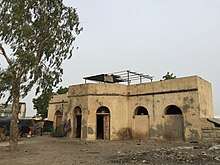James MacMurdo
Captain James MacMurdo was the first political resident of British East India Company to Cutch State. He played important role in bringing Cutch under British suzerainty.
James MacMurdo | |
|---|---|
| Born | November 30, 1785 |
| Died | April 28, 1820 (aged 34) |
| Resting place | Varnu, Kutch |
| Occupation | Political resident agent |
| Employer | British East India Company |
Biography
MacMurdo was born on 30 November 1785 in Dumfriesshire in Scotland. Lieutenant MacMurdo entered the military service in 1801 ; commanded the Resident's Guard at Baroda State and served as Aide-de-Camp to Lieutenant- General Oliver Nicolls, Commander-in-Chief of Bombay.
He entered Cutch in the guise of Ramanandi monk. He resided ar Madhavrai's Temple in Anjar and his religious activities earned him nickname, Bhuriya Bava. He spoke local language and had understanding of local customs.[1][2][3]
In 1816, he was sent to Rao of Cutch state for issues regarding piracy in Arabian Sea and bandits from Vagad region entering into North Gujarat. In 1816, the Rao Bharmalji II agreed to the suzerainty of the British and he was appointed as the British Resident at Bhuj and Collector of Anjar.[4][5][6]
With support of some Jadeja chiefs, the British troops led by Colonel East attacked Bhuj on 25 March 1819, and disposed Rao Bharmalji II[7] and his son Deshalji II, a minor was made the ruler of Cutch State. In 1819, MacMurdo was posted as British Political Resident stationed at Bhuj. During Deshalji's minority, the affairs of the State were managed by Council of Regency, which was composed of Jadeja chiefs and was headed by MacMurdo.[8][9][10]
During his stay in Anjar, he built MacMurdo's Bungalow with wall paintings which has the themes from Ramayana. It is now State Protected Monument.[1][2] In 1819, he experienced the earthquake in Anjar and sent detailed reports regarding it to Bombay.[11] He wrote several books and reports regarding Sindh and Kutch regions.
He died on 28 April 1820 at Varnu near Rann of Kutch and was buried near the temple of Venudada located in the village. The people of village believe that he slept in the Venudada temple which resulted in his death though his tomb is marked that he died of Cholera,[1][11][12][13] probably during the first Asiatic cholera pandemic.
His tomb reads,[1]
IN MEMORIAM
CAPTAIN JAMES MAC MURDO
FIRST BRITISH POLITICAL
RESIDENT IN CUTCH
DIED OF CHOLERA AT WARNU
ON 28 APRIL 1820
Further reading
- Shah, Kunjlata (2018). Tikekar, Aroon (ed.). Captain James Macmurdo. Founders and Guardians of The Asiatic Society of Mumbai. Bombay: Indus Source Books. ISBN 9789385509377.
References
Notes
- "Warnu Dada Temple". Megalithic Portal Gallery. 28 October 2007. Retrieved 1 August 2015.
- Ward (1 January 1998). Gujarat–Daman–Diu: A Travel Guide. Orient Longman Limited. p. 333. ISBN 978-81-250-1383-9.
- Virbhadra Singhji (1 January 1994). The Rajputs of Saurashtra. Popular Prakashan. p. 207. ISBN 978-81-7154-546-9.
- Great Britain. Parliament. House of Commons (1818). Parliamentary Papers, House of Commons and Command. H.M. Stationery Office. p. 2.
- "Transactions of the Literary Society of Bombay". Google Books. 5 October 2015. Retrieved 22 October 2015.
- Gazetteer of the Bombay Presidency: Cutch, Palanpur, and Mahi Kantha 1880, p. 158.
- Gazetteer of the Bombay Presidency: Cutch, Palanpur, and Mahi Kantha 1880, p. 162.
- Bhuj:art, architecture, history.
- Jadeja Rulers of Kutch : Deshalji II (1814-1860) Archived 2011-06-13 at the Wayback Machine
- Kutch State : Maharao DESALJI BHARMALJI II (Daishalji) 1819/1860 Archived 2011-06-05 at the Wayback Machine
- Iain S. Stewart; Claudio Vita-Finzi (1 January 1998). Coastal Tectonics. Geological Society of London. p. 311. ISBN 978-1-86239-024-9.
- Blackwood's Edinburgh Magazine. W. Blackwood. 1821. p. 120.
- "For over two centuries, village in Gujarat grieves over death of a Rajput chieftain : OFFTRACK". India Today. 30 September 1994. Retrieved 31 July 2015.
Bibliography
- Gazetteer of the Bombay Presidency: Cutch, Palanpur, and Mahi Kantha. Government Central Press. 1880. pp. 158–162.

